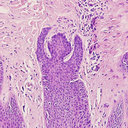Activation in vitro of respiratory nitrate reductase of Escherichia coli K12 grown in the presence of tungstate. Involvement of molybdenum cofactor.
Palabras clave
Abstracto
The chlorate-resistant (chlR) mutants are pleiotropically defective in molybdoenzyme activity. The inactive derivative of the molybdoenzyme, respiratory nitrate reductase, present in the cell-free extract of a chlB mutant, can be activated by the addition of protein FA, the probable active product of the chlB locus. Protein FA addition, however, cannot bring about the activation if 10 mM sodium tungstate is included in the culture medium for the chlB strain. The inclusion of a heat-treated preparation of a wild-type or chlB strain prepared after growth in the absence of tungstate, restores the protein-FA-dependent activation of nitrate reductase. All attempts to activate nitrate reductase in extracts prepared from tungstate-grown wild-type Escherichia coli strains failed. It appears that during growth with tungstate, the possession of the active chlB gene product leads to the synthesis of a nitrate reductase derivative which is distinct from that present in the tungstate-grown chlB mutant. Heat-treated preparations from chlA and chlE mutants which do not possess molybdenum cofactor activity fail to restore the activation. Fractionation by gel filtration of the heat-treated preparation from a wild-type strain produced two active peaks in the eluate of approximate Mr 12000 and less than or equal to 1500. The active material in the heat-treated extract was resistant to exposure to proteinases, but after such treatment the active component, previously of approximate Mr 12000, eluted from the gel filtration column with the material of Mr less than or equal to 1500. The active material is therefore of low molecular mass and can exist either in a protein-bound form or in an apparently free state. Molybdenum cofactor activity, assayed by the complementation of the apoprotein of NADPH:nitrate oxidoreductase in an extract of the nit-1 mutant of Neurospora crassa, gave a profile following gel filtration similar to that of the ability to restore respiratory nitrate reductase activity to the tungstate-grown chlB mutant soluble fraction. This was the case even after proteinase treatment of the heat-stable fraction. Analysis of the chlC (narC) mutant, defective in the structural gene for nitrate reductase, revealed that heat treatment is not necessary for the expression of the active component. Furthermore both the active component and molybdenum cofactor activity are present in corresponding bound and free fractions in the non-heat-treated soluble subcellular fraction.(ABSTRACT TRUNCATED AT 400 WORDS)


